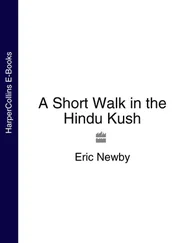It is certainly responsible for more good than evil. Even cholera, one of the great killers, does not go down the river. It is born in the stagnant waters of the Delta in Bengal and ascends it carried by pilgrims who visit the sacred places in hundreds of thousands every year. The great nineteenth-century epidemics started in Bengal, spread to Hardwar, one of the holiest places of all on the Upper Ganges; then north-west into the Punjab and from there overland into Afghanistan, Persia, Russia and finally into Western Europe. Even today the seasonal rise in the incidence of cholera coincides with the great religious fairs which take place on the banks of the river.
The Ganges first sees the light of day when it emerges from an ice cave above Gangotri, 13,800 feet up in the Garhwal Himalayas. Hindus believe that it was from this cave that Ganga, the daughter of King Himavat and the nymph, Mena, was persuaded to come down to earth by Bhagiratha, a descendant of King Sagar, in order to redeem from hell the souls of the sixty thousand sons of the king who had been reduced to ashes by a holy man whom they had slighted.
There is some dispute between the devotees of Siva and Vishnu, the two principal sects of Hindus, as to which god assisted at the birth of Ganga . Vishnuvites believe that she rose from the big toe of Vishnu’s left foot, Sivites say that to break her fall on earth Siva allowed her to flow through his hair, which can still be seen hanging in the form of icicles from the roof of the cave.
At Hardwar, with twelve hundred miles of its course still to run to its nearest outlet to the sea it has already fallen 12,800 feet and here, only 1,000 feet above the sea, it begins to irrigate the land with the aid of wells and canals, and to give electric power. On its way to the sea it passes through three states: Uttar Pradesh, Bihar and West Bengal. In them live 150,000,000 people, almost a third of the entire population of India. Of these nearly half live in Uttar Pradesh. There are 69,000 villages in Uttar Pradesh with populations of less than 500 and in this state more than eighty per cent of the cultivated holdings are of less than five acres (some are as little as half an acre). For much of its course the Ganges is not a navigable river in the real sense of the word, although, in spite of the fact that millions of cubic feet of water are drawn off from it, its strength is constantly renewed by the rivers that flow into it. It is in the 600-mile stretch between Allahabad and Rajmahal that it really gathers strength. At Rajmahal, in full flood, it goes down at 1,000,800 cubic feet a second which is greater than the maximum discharge of the Mississippi (the Thames at Staines discharges at 6,600 feet a second in full flood). Fortunately it brings down with it vast quantities of silt which it deposits free of charge for a season before sweeping it further downstream. A Victorian engineer, Sir Charles Lyell, estimated that 335,000,000 tons of silt were discharged each year at Ghazipur on the Middle Ganges. ‘Nearly the weight of sixty replicas of the Great Pyramid.’ A useless comparison. ‘It is scarcely possible,’ he goes on, ‘to present any picture to the mind which will convey an adequate conception to the mind of the mighty scale of this operation, so tranquilly and almost insensibly carried out by the Ganges.’ Whether some smallholder in Bihar, watching his half-acre slipping noisily into the water and his family being swept downstream on top of a haystack would regard the operation as being either tranquil or insensible is open to question. No one knows for certain the depth of the alluvial silt in the Delta.
Like the black sheep of the family sent to Australia, the Ganges is always trying to straighten itself out. It sets its current strongly against one bank, undercutting it and leaving sluggish water on the other shore on which new deposits are made, until it finally breaks through and begins the whole process afresh. The Gangetic Plain is riddled with old, dead watercourses that the Ganges has forgotten about. At Kasimbazar in Bengal, where one of the first British trading stations was established in 1658, there is a flight of steps from which it is said that Warren Hastings used to come ashore. Only the river has gone, leaving a few pools choked with water hyacinth. The once illustrious city of Kanauj on the Upper Ganges is now so far from the actual stream that, passing it in a boat in the dry season, one does not realise that it is there at all. Rajmahal, once the capital of Bengal, was left high and dry, three miles from it, in 1863. Later, in the seventies, it was seven miles from it. Now the Ganges has returned. Too late, the city is moribund. The Bhagirathi, the short, eighty-mile stretch which connects it with the Hooghly, is more or less dry for eight months of the year. Power-vessels bound for Calcutta have to make a 400-mile detour through East Pakistan to reach the port which is itself always in danger of suffering the same fate as Rajmahal. Four hundred miles out in the Bay of Bengal the sea is discoloured by the silt brought down by it. The Ganges justifies the one hundred and second name given it in the Gangastottara-satanamavali – ‘Roaming About Rose-Apple-Tree Island’, which is India.
Note: All diacritical marks which correctly should appear in Indian names have been omitted in this book.
Gangastottara-sata-namavali
(The 108 names of the Ganges)
| 1 Ganga |
Ganges |
| 2 Visnu-padabja-sambhuta |
Born from the lotus-like foot of Vishnu |
| 3 Hara-vallabha |
Dear to Hara (Siva) |
| 4 Himacalendra-tanaya |
Daughter of the Lord of Himalaya |
| 5 Giri-mandala-gamini |
Flowing through the mountain-country |
| 6 Tarakarati-janani |
Mother of [the demon] Taraka’s enemy (i.e. Kartikeya) |
| 7 Sagaratmaja-tarika |
Liberator of the [60,000] sons of Sagara (who had been burnt to ashes by the angry glance of the sage Kapila) |
| 8 Sarasvati-samayukta |
Joined to [the river] Sarasvati (said to have flowed underground and joined the Ganges at Allahabad) |
| 9 Sughosa |
Melodious (or: Noisy) |
| 10 Sindhu-gamini |
Flowing to the ocean |
| 11 Bhagirathi |
Pertaining to the saint Bhagiratha (whose prayers brought the Ganges down from Heaven) |
| 12 Bhagyavati |
Happy, fortunate |
| 13 Bhagiratha-rathanuga |
Following the chariot of Bhagiratha (who led the Ganges down to Hell to purify the ashes of Sagara’s sons) |
| 14 Trivikrama-padoddhuta |
Falling from the foot of Vishnu |
| 15 Triloka-patha-gamini |
Flowing through the three worlds (i.e. Heaven, earth and the atmosphere or lower regions) |
| 16 Ksira-subhra |
White as milk |
| 17 Bahu-ksira |
[A cow] which gives much milk |
| 18 Ksira-vrksa-samakula |
Abounding in [the four] ‘milk-trees’ (i.e. Nyagrodha (Banyan), Udumbara (glomer ous fig-tree), Asvattha (holy fig-tree), and Madhuka (Bassia Latifolia)) |
| 19 Trilocana-jata-vasini |
Dwelling in the matted locks of Siva |
| 20 Rna-traya-vimocini |
Releasing from the Three Debts, viz. (1) Brahma-carya (study of the Vedas) to the rishis, (2) sacrifice and worship to the gods, and (3) procreation of a son, to the Manes |
| 21 Tripurari-siras-cuda |
The tuft on the head of the enemy of Tripura (Siva). (Tripura was a triple fortification, built in the sky, air and earth of gold, silver and iron respectively, by Maya for the Asuras, and burnt by Siva) |
| 22 Jahnavi |
Pertaining to Jahnu (who drank up the Ganges in a rage after it had flooded his sacrificial ground, but relented, and allowed it to flow from his ear) |
| 23 Nata-bhiti-hrt |
Carrying away fear |
| 24 Avyaya |
Imperishable |
| 25 Nayanananda-dayini |
Affording delight to the eye |
| 26 Naga-putrika |
Daughter of the mountain |
| 27 Niranjana |
Not painted with collyrium (i.e. colourless) |
| 28 Nitya-suddha |
Eternally pure |
| 29 Nira-jala-pariskrta |
Adorned with a net of water |
| 30 Savitri |
Stimulator |
| 31 Salila-vasa |
Dwelling in water |
| 32 Sagarambusa-medhini |
Swelling the waters of the ocean |
| 33 Ramya |
Delightful |
| 34 Bindu-saras |
River made of water-drops |
| 35 Avyakta |
Unmanifest, unevolved |
| 36 Vrndaraka-samasrita |
Resort of the eminent |
| 37 Uma-sapatni |
Having the same husband (i.e. Siva) as Uma (Parvati) |
| 38 Subhrangi |
Having beautiful limbs (or body) |
| 39 Srimati |
Beautiful, auspicious, illustrious, etc. |
| 40 Dhavalambara |
Having a dazzling white garment |
| 41 Akhandala-vana-vasa |
Having Siva as a forest-dweller (hermit) |
| 42 Khandendu-krta-sekhara |
Having the crescent moon as a crest |
| 43 Amrtakara-salila |
Whose water is a mine of nectar |
| 44 Lila-lamghita-parvata |
Leaping over mountains in sport |
| 45 Virinci-kalasa-vasa |
Dwelling in the water-pot of Brahma (or Vishnu, or Siva) |
| 46 Triveni |
Triple-braided (i.e. consisting of the waters of three rivers: Ganges, Yamuna and Sarasvati) |
| 47 Trigunatmika |
Possessing the three gunas |
| 48 Sangataghaugha-samani |
Destroying the mass of sins of Sangata |
| 49 Sankha-dundubhi-nisvana |
Making a noise like a conch-shell and drum |
| 50 Bhiti-hrt |
Carrying away fear |
| 51 Bhagya-janani |
Creating happiness |
| 52 Bhinna-brahmanda-darpini |
Taking pride in the broken egg of Brahma |
| 53 Nandini |
Happy |
| 54 Sighra-ga |
Swift-flowing |
| 55 Siddha |
Perfect, holy |
| 56 Saranya |
Yielding shelter, help or protection |
| 57 Sasi-sekhara |
Moon-crested |
| 58 Sankari |
Belonging to Sankara (Siva) |
| 59 Saphari-purna |
Full of fish (esp. Cyprinus Saphore – a kind of bright little fish that glistens when darting about in shallow water – or carp) |
| 60 Bharga-murdha-krtalaya |
Having Bharga’s (Siva’s) head as an abode |
| 61 Bhava-priya |
Dear to Bhava (Siva) |
| 62 Satya-sandha-priya |
Dear to the faithful |
| 63 Hamsa-svarupini |
Embodied in the forms of swans |
| 64 Bhagiratha-suta |
Daughter of Bhagiratha |
| 65 Ananta |
Eternal |
| 66 Sarac-candra-nibhanana |
Resembling the autumn moon |
| 67 Om-kara-rupini |
Having the appearance of the sacred syllable Om |
| 68 Atula |
Peerless |
| 69 Krida-kallola-karini |
Sportively billowing |
| 70 Svarga-sopana-sarani |
Flowing like a staircase to Heaven |
| 71 Sarva-deva-svarupini |
Embodied in the pantheon |
| 72 Ambhah-prada |
Bestowing water |
| 73 Duhkha-hantri |
Destroying sorrow |
| 74 Santi-santana-karini |
Bringing about the continuance of peace |
| 75 Daridrya-hantri |
Destroyer of poverty |
| 76 Siva-da |
Bestowing happiness |
| 77 Samsara-visa-nasini |
Destroying the poison of illusion |
| 78 Prayaga-nilaya |
Having Prayaga (Allahabad) as an abode |
| 79 Sita |
‘Furrow’. Name of the eastern branch of the four mythical branches into which the heavenly Ganges is supposed to divide after falling on Mount Meru |
| 80 Tapa-traya-vimocini |
Releasing from the Three Afflictions |
| 81 Saranagata-dinarta-paritrana |
Protector of the sick and suffering who come to you for refuge |
| 82 Sumukti-da |
Giving complete [spiritual] emancipation |
| 83 Siddhi-yoga-nisevita |
Resorted to (for the acquisition of success or magic powers) |
| 84 Papa-hantri |
Destroyer of sin |
| 85 Pavanangi |
Having a pure body |
| 86 Parabrahma-svarupini |
Embodiment of the Supreme Spirit |
| 87 Puma |
Full |
| 88 Puratana |
Ancient |
| 89 Punya |
Auspicious |
| 90 Punya-da |
Bestowing merit |
| 91 Punya-vahini |
Possessing (or producing) merit |
| 92 Pulomajarcita |
Worshipped by Indrani (wife of Indra) |
| 93 Puta |
Pure |
| 94 Puta-tribhuvana |
Purifier of the Three Worlds |
| 95 Japa |
Muttering, whispering |
| 96 Jangama |
Moving, alive |
| 97 Jangamadhara |
Support or substratum of what lives or moves |
| 98 Jala-rupa |
Consisting of water |
| 99 Jagad-d-hita |
Friend or benefactor of what lives or moves |
| 100 Jahnu-putri |
Daughter of Jahnu |
| 101 Jagan-matr |
Mother of what lives or moves |
| 102 Jambu-dvipa-viharini |
Roaming about (or delighting in) Rose-apple-tree Island (India) |
| 103 Bhava-patni |
Wife of Bhava (Siva) |
| 104 Bhisma-matr |
Mother of Bhisma |
| 105 Siddha |
Holy |
| 106 Ramya |
Delightful, beautiful |
| 107 Uma-kara-kamala-sanjata |
Born from the lotus which created Uma (Parvati) (presumably a poetic way of saying that they were sisters) |
| 108 Ajnana-timira-bhanu |
A light amid the darkness of ignorance |
CHAPTER ONE Long ago on the Ganges
Читать дальше












